
(Interplanetary Hearing Device)
Interview with Tosca Hidalgo y Terán by Olivia Ann Carye Hallstein
Tosca Hidalgo y Terán is an internationally exhibited and recognized creator of interactive environments and objects that provide shared experiences surrounding topics of entanglement and interconnectedness. Using her unique perspective on the world and the magic that lives within it, she has employed engineering and technologies to tackle often difficult topics. Her work creating musical collaborations with mycelium has led to incredible insights into the consciousness and interconnectedness of the world around us all.
Hi Tosca, I am so excited to interview you this month. Can we dig right into your interactive musical collaborations with mycelium? You even mention that the mycelium reacts differently to different people.
I believe fungi are sentient, have cognition. Perhaps, too this sentience or awareness is more expansive than human due to its very nature. Mycelium consistently generates periodic patterns that are both enigmatic and very musical. For reasons that I do not fully understand, Mycelium reacts to the proximity of some people more than others—growing more frenetic or more harmonic or completely silent when humans are present.
In 2019 while I was a resident bio-artist during a MOCA Toronto and Ontario Science Centre partnership, MOCA offered resident artists a 500+ square foot studio in their building. Also, on the 3rd floor of MOCA central sat the Akin artist’s studio spaces and once or twice a month, they would hold open studio events. During one such occasion, fellow Alien Agency Collective artists Joel Ong, Nicole Clouston, and I opened our temporary bio-art studio to the public to share our various research in progress. My Mycelium, Martian Dome project, sponsored by Ecovative Design, Moog Audio, and The Brothers Dressler. I had a massive sound system set up for this open studio, synthesizers connected to living mycelium I had sculpted into the shape of a brain. The Myco-brain contained inside a plexiglass case with electrodes threaded through holes; this case was covered in black cloth. There was also a greenhouse set-up that housed large mushroom bags and Petri dishes of growing Ganoderma lucidum, Pleurotus ostreatus and djamor, Stropharia rugosoannulata and Armillaria mellea.
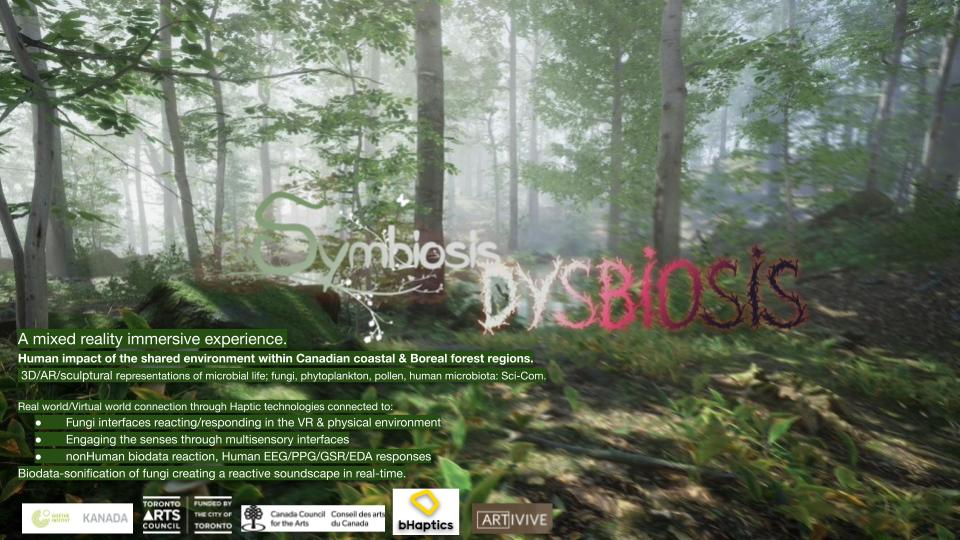 (Symbiosis/Dysbiosis, Remote Residencies)
(Symbiosis/Dysbiosis, Remote Residencies)
Guests would enter the studio and hear an ambient mycelium soundscape playing. Rapid, chaotic shifts in the soundscape made it quite obvious the fungi were responding to the people. Children picked up on this quickly and started to play with this interactivity. They would run-up to the Myco-brain and then run out of the space. The adults in the room did not know what to make of this, were the fungi responding to vibrations? Then, quite abruptly, the soundscape stopped playing. At that moment, everyone turned towards the entrance to see a man standing there. To be fair to this person, I have no idea what they were experiencing or going through; there was an aggressive, Joker is wild, air about them. They frantically walked into the studio space and made a bee-line for the greenhouse. I asked them to please refrain from opening it, but I would happily open it if they wanted to see inside. Before I could finish my sentence, they cut me off aggressively, yelling, “Why, is the monster in there?!” Chuckling, I replied, I am just cautious about contamination, and with that, they wildly moved through the studio space and out the door. In the exact moment they crossed the threshold, the soundscape started back up, and everyone in the studio gasped.
One couple left saying that this entirely freaked them out, the mushroom going silent to come back to life then. Now, sure this may have been a curious coincidence, but I don’t think it was. During my Primordia installation at Grow-Op 2019, where I installed an unground mycelium cave in a historic hotel room, similar occurrences took place where people would affect the mycelium - without touching it!
 (Detail View of Forest UnderSound 2021)
(Detail View of Forest UnderSound 2021)
Holy Moly! That's truly unbelievable. And the work continues: in your monthly podcast you share your recent interactions with mycelium. What have you noticed over the course of this work in different spaces?
I’ve been very fortunate to receive invitations to residencies abroad pre-pandemic which brought me to the Southern Hemisphere (Australia and New Zealand). Different seasons offer different fungi. I also cultivate various mycelium so when I am home or at my studio over the winter there is always fungi growing nearby. ;) Trees are a different story.

(Exhibition View of Forest UnderSound 2021)
And can you discuss a bit about how it is made? What are the technical components that are necessary to create these interactions?
The Symbiosis/Dysbiosis project, generously supported by the Goethe-Institute Montreal, Canada Arts and Toronto Arts councils, is a fully immersive, mixed reality, participatory experience working with living mycelium biodata-sonification within a VR environment. I am collaborating with media artist Allison Moore collecting photogrammetry point clouds scanned from coastal rainforests and Canadian Boreal Forest regions to visualize the VR environment. Projection-mapped floor and wall(s) around the VR space allow visitors within the installation, outside of the VR forests, to interact with the point cloud visuals by stepping on pressure-sensitive mats and touching the projection-mapped surfaces. These actions send data into the VR environment representing an impact within the forest. Living mycelium from locally cultivated fungi responds to the installation's human presence while creating a generative soundscape. Human EEG/PPG/EDA/GSR influences each "player's" VR experience.
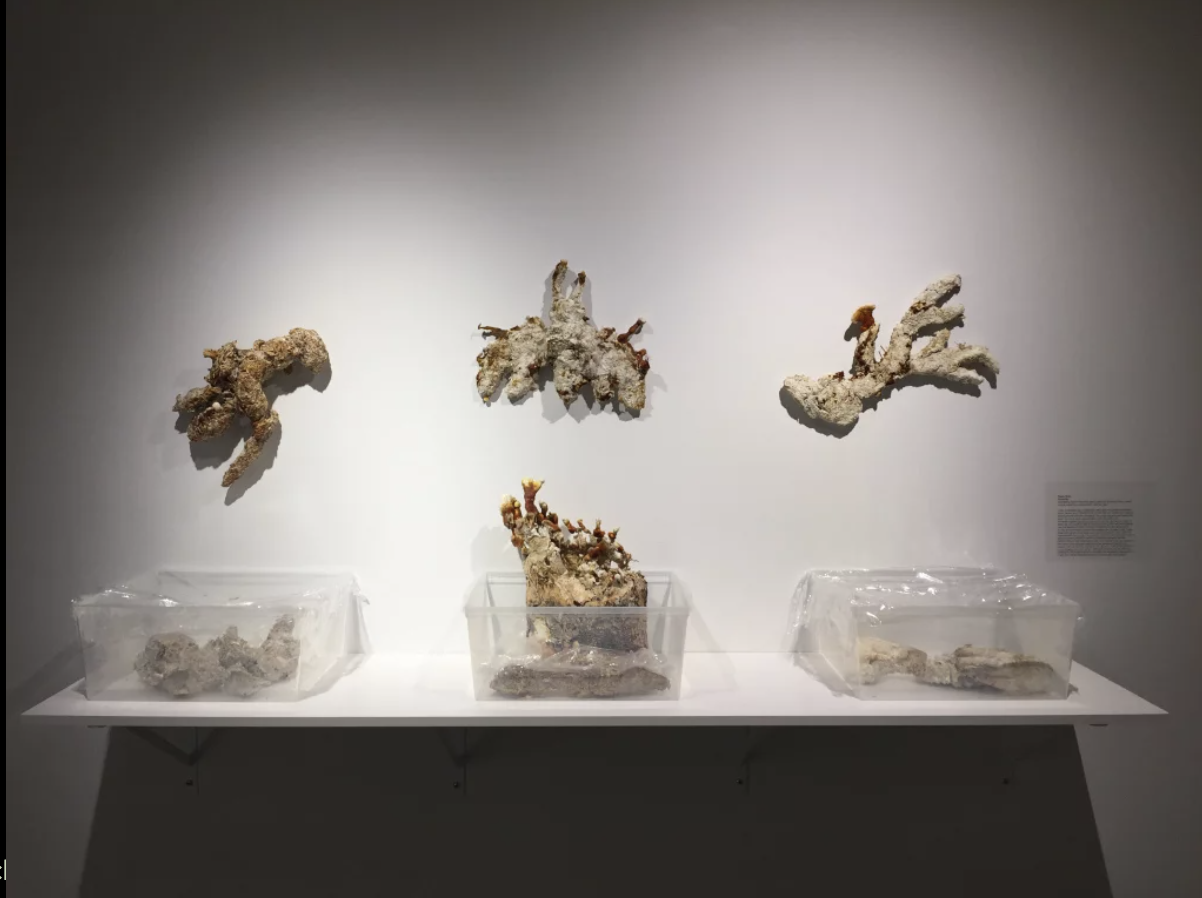 (Exhibition View Chaos Fungorum, 2018)
(Exhibition View Chaos Fungorum, 2018)
Sonically speaking, I've been working with various purpose-built circuits to detect micro-fluctuations in conductivity, translating this activity in real-time to MIDI notes and controls or voltage control signals.
The primary concept involves visualizing interactions between human and non-human microbiota and the shared environment through macro visualizations of the microbial life on us, around us in the air, trees, fungi, pollen, pollutants. Collaborator and neuroscientist Brendan Lehman has developed code that integrates biodata readings captured in real-time into the virtual environment. Specifically, we are developing for the OpenBCI and Emotibit platforms. I've been awarded an artist research residency at the Coalesce Centre for Biological Art with Dr. Paul Vanouse. During this residency, mycelium is grown and observed using SEM, AFM and Confocal microscopy. This imagery is being captured and integrated into the VR experience of Sym/Dys. I am looking forward to jumping into the mycelium network on a microbial level. Sonically speaking, I've been working with various purpose-built circuits to detect micro-fluctuations in conductivity, translating this activity in real-time to MIDI notes and controls or voltage control signals. MIDI and control voltage enables me to patch directly into my analog and digital synthesizers, creating a mycelial network soundscape. One of the bio-sonification modules I build comes from engineer Sam Cusumano of Electricity for Progress. Initially, I purchased a PCB and a few electrical components from Manuel Domke, who also shared a schematic and Arduino code with me back in 2017. Before that, I was building my touch sensors towards "listening" to various mycelium.
Your work with mycelium goes beyond musical collaboration, but also into creating vegan leather-alternatives by growing the mushrooms directly into form. Can you describe this process and where this is leading?
Admittedly, this research took a bit of a back-burner status over the pandemic. Though I have been consulting several artists towards sculpting, forming, and growing their own pellicles with mycelium. First cultivating their own and then expanding upon that. One project involves developing large, mycelium-covered surfaces that will act like an artist’s canvas’ to explore how the mycelium might remediate paint - the artist works in acrylic and oils, sometimes watercolours. Another consult is growing hollow sculptural forms with an assistant prof at York University to house electronics that work with IoT devices taking readings from a nearby Ontario forest.
You mention that the pandemic has influenced your practice. Can you expand on this please?
With the pandemic and restrictions, my retreating into the forest primarily took shape in the virtual. More time to focus on sound creations, 3D work (3D, VRML, QTVR, and HTML is something I was very much into when I lived in New Mexico in the ’90s), and exploring haptic sensors and solenoid-based projects. I was fortunate with the Mycorrhizal Rhythm Machine installation at New Adventures in Sound Art as it included a short residency at their northern Ontario resort, several kilometres from Algonquin Park and next to Deer Lake. Algonquin Park is simply breathtaking, and there is a lot to explore fungi-wise. I collected a lot of biodata and field recordings of the Dawn Chorus while there.
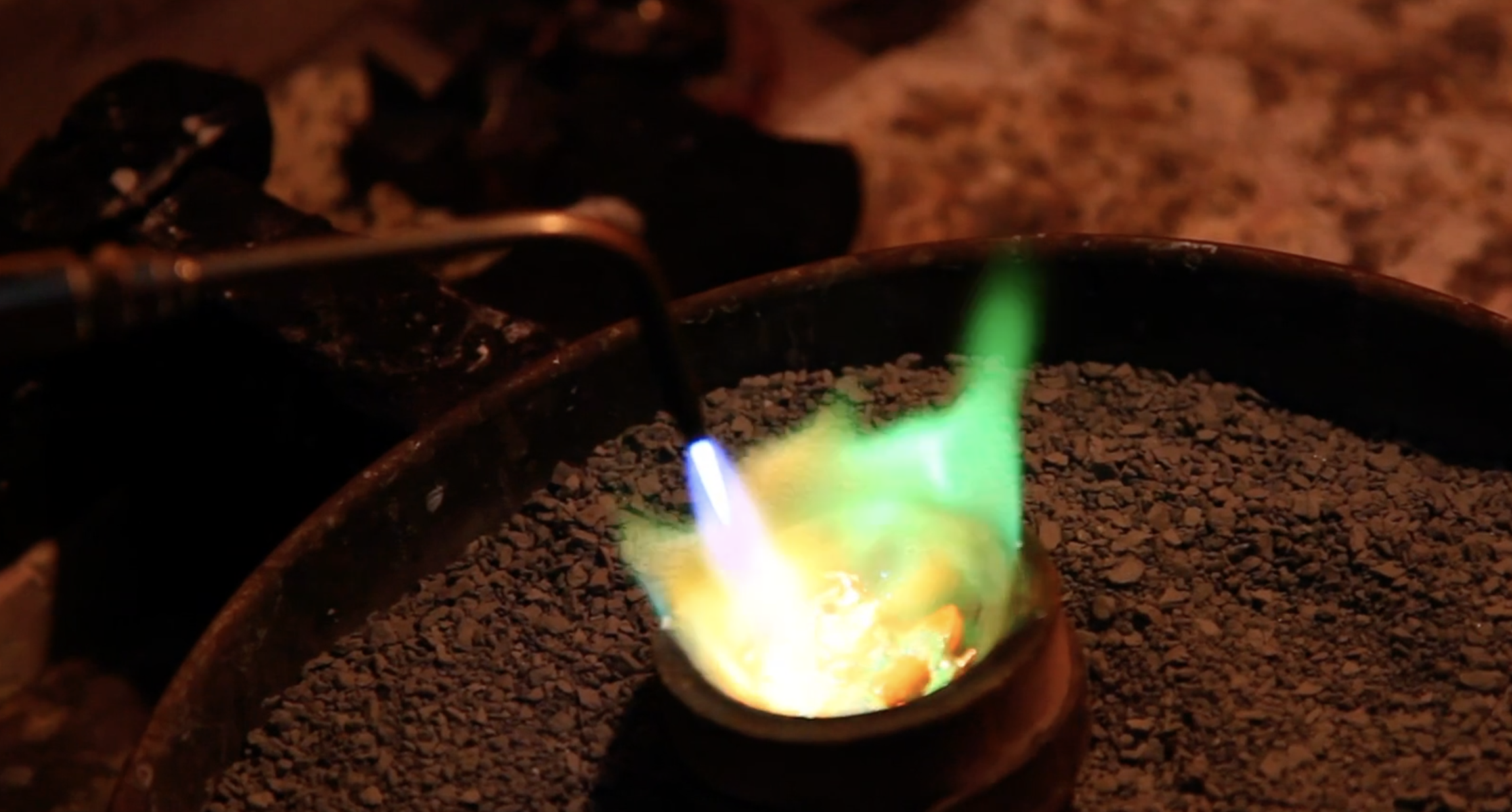 (Still from Nanopod, Pascal Perich)
(Still from Nanopod, Pascal Perich)
Your early work involves using glass and metals to sculpt wearable objects depicting your dreams and thoughts about decay. How does your relationship and workflow with such solid forms contrast to the fluid, living musical and interactive space work?
Many of my past metal and glass works involved soundscapes. Imagining the sounds of the worlds and environments where such objects come from or dwell. Descent to Perelandra, Orbis Tertius and An UnNatural History are bodies of metal and glass works (some wearable) that explored soundscapes and immersive installation. I’ve been revisiting metal and glass projects from 2004, where I started to incorporate various Bone conductance output and touch capacitance. Glass is an incredible medium for this because you can embed metals into molten glass. Burnish gold and fine silver onto the surface of hot-glass, or fume metals onto glass, grow metal onto the Glass through Electro-forming; there are a lot of potentials. Incorporating living fungi adds yet another reactive element.
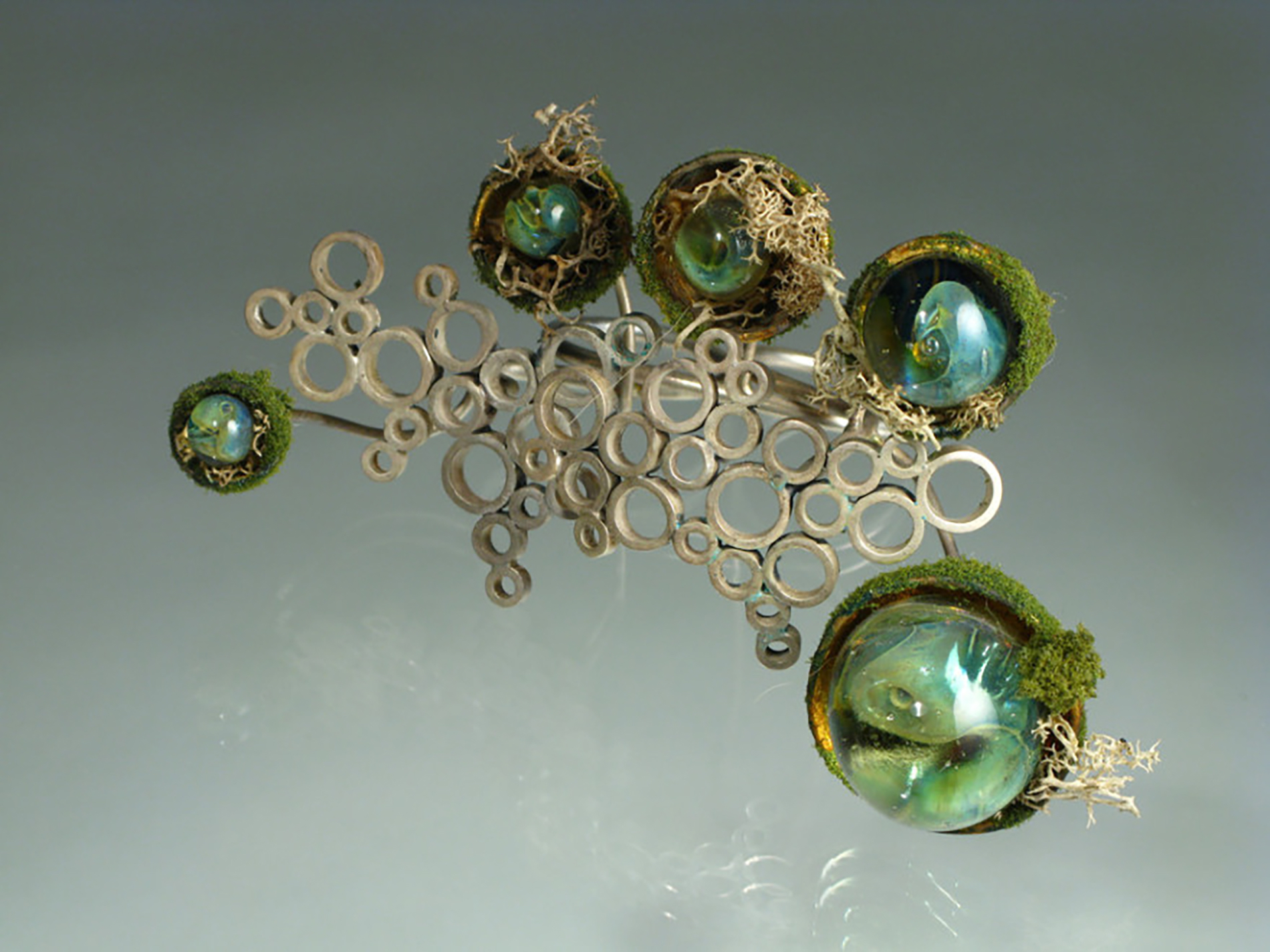 (An UnNatural History, Metal and Glass)
(An UnNatural History, Metal and Glass)
There are a lot of potentials. Incorporating living fungi adds yet another reactive element.
In the video “Nanopod”, you talk about your dreams and relationship to death. What do you decide to bring into this world from those dreams and what are some of your hopes for the work?
When I was a child, I had recurring nightmares that involved a family member that would transform (not be who I had thought they were) and try to take my life multiple times every night I went to sleep. These nightmares began and lasted from ages 3 to late teens. The family member in my nightmares was similar to a vampire yet, not a vampire. These were also flying dreams; armies of flying skeletons would arrive to take me away. Much later in life, I would learn that this person showing up in my nightmares suffered from postpartum depression, heard voices, and had considered taking my life. That is a lot to carry, both for myself and definitely for the person being my mother. As a young person and artist, I wanted to understand the "darker" aspects of nature, psychological, mythical, occult and these ideas and nightmares made their way into my work.
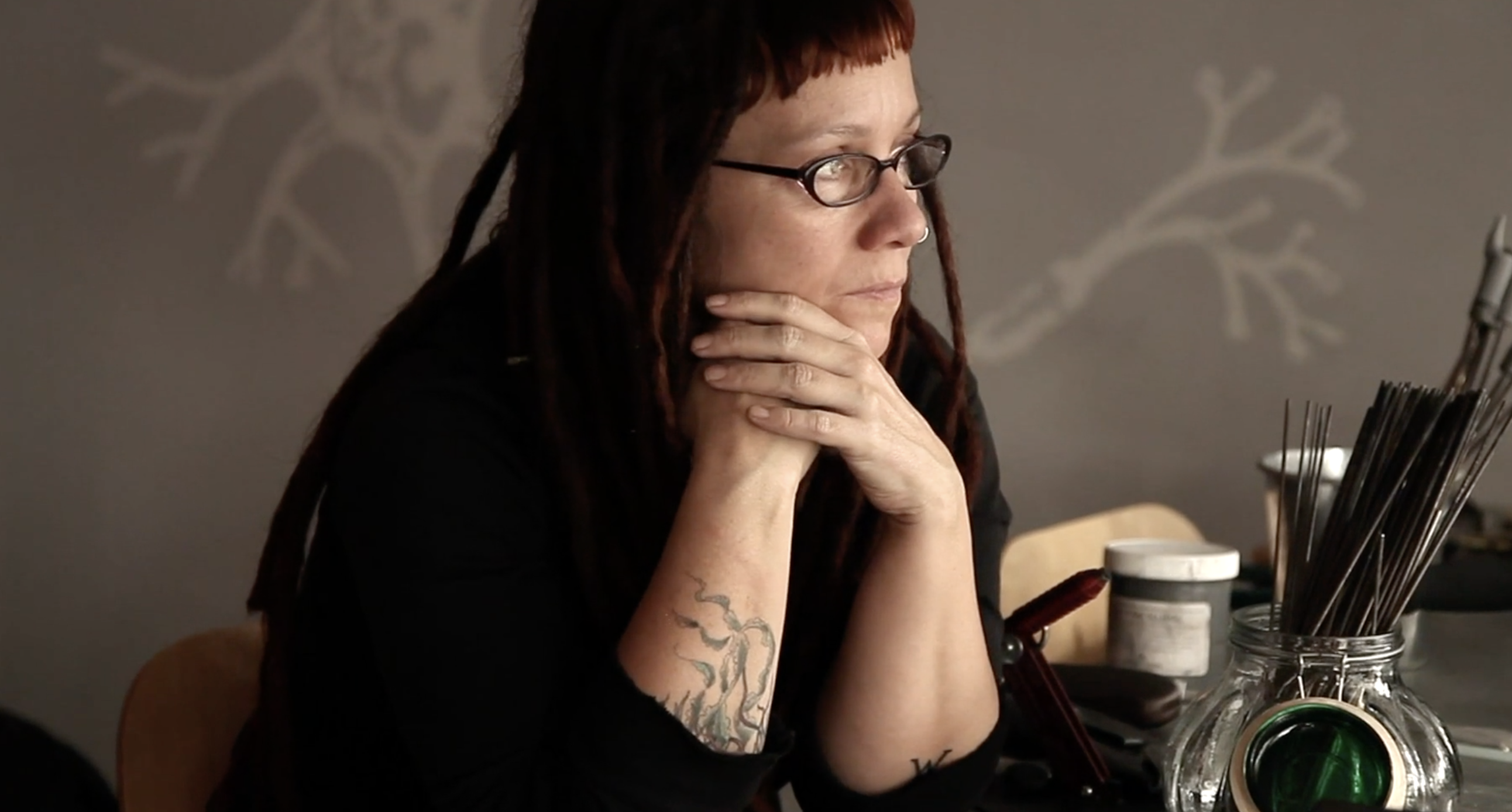 (Still from Nanopod, Pascal Perich)
(Still from Nanopod, Pascal Perich)
As a young person and artist, I wanted to understand the "darker" aspects of nature, psychological, mythical, occult and these ideas and nightmares made their way into my work.
Later in life, I had two near-death experiences from ectopic pregnancies. A particular work that truly manifested "Motherhood" for me was, Inside Incubus. Inside Incubus was a web narrative and a physical work I built to combat sorrow, poor self-image, and dragons, if you will. The metal-made physical version was interestingly very popular with people; it received fan mail and poems! The web narrative began with an animated paper doll version of myself, which divided into twins after a while and led visitors deeper into the forest (mind) through visuals and sounds. Visitors traveled either the left-hand path or the right. With the virtual death of fabulous flash-based websites, Inside Incubus was archived. I've considered revisiting it and creating an updated VR version that would now, I suppose, start venturing into the Crone
Thank you for sharing, your story is incredibly touching. You have such a unique and magical perspective on the world. How have your multiple cultural influences (Mexican, German, Canadian, etc) helped form this perspectice?
Dia de Los Muertos always held an appeal to me. My grandfather would bring me marionettes from Mexico; skeletons, animals, strange characters, along with chocolate-covered ants! I have learned a lot about my father's family later in life. My paternal grandparents wanted me to learn Spanish and more about their culture/my culture, while unfortunately, my father lived through a lot of racism that his parents did not experience. So, I did not grow up speaking Spanish at home. My grandparents and father also did not practice Catholicism. There's a long story regarding family name changes during the Spanish inquisition and a great-great uncle's head being removed. Fidel Castro is (was?) a relative. So, there certainly is a lot to draw from, familially and culturally speaking.
Science Fiction and Fantastical worlds inspired me, and now I guess my love of SciFi and electronic and classical music continues through more bio-art explorations.
I look at Scandinavian, Germanic, Celt land-wise on my maternal side, but I feel more connected to my father, and everything unsaid. But how any of this informs my work, I am uncertain. Childhood dreams of transforming into different shapes; machine and animal. I would then describe driving vehicles with windscreens like televisions (it was the '70s, and I was 5). I was visiting different worlds, both extraterrestrial and subterranean. Unlike my peers, I repeatedly listened to Klaus Schulze, Tomita and experiencing films like Planet Sauvage, Silent Running, Heavy Metal magazine, and Giger's Necronomicon had a significant impact. Science Fiction and Fantastical worlds inspired me, and now I guess my love of SciFi and electronic and classical music continues through more bio-art explorations. My musical tastes have remained constant; only now, along with my partner, I create the electronic soundscapes.
Lastly, in “creating artwork to raise awareness,” what do you want your audience to take away from interacting with your spaces? What are the most pressing issues of today for you and the work that you create?
There is seemingly more awareness and sensitivity towards your particular interests and focus when you are an artist. In my instance, this involves the shared environment through nonhuman kinships and entanglements. Human communication is tricky. People often do not tell the truth or hide, or worse, they blame other people for their problems. I am not feeling better or more aware than other folks by sharing this. It is simply vital to know who you work with and their motivations. The COVID-19 Pandemic certainly affected all life, and bringing more awareness to this remains essential. It is unfortunate to be shouting at the air.

(Jokulsarlon Chopines Beast, Metal and Glass)
I am creating spaces and object-based experiences that open memories, that perhaps ground people into the now, that make slight adjustments to human-centric beliefs and movement.
When I wrote, creating artwork to raise awareness, this is multi-faceted because it also pertains to myself as a human. Over the years, I have met people utterly moved to tears by my work, by spaces I have created and shared. Over the Pandemic, I have had time to reflect on this and ask what moved them, what brought on the emotional response? I would like to believe that I am not merely creating more content. I am creating spaces and object-based experiences that open memories, that perhaps ground people into the now, that make slight adjustments to human-centric beliefs and movement. Maybe this is what brings on the empathic responses. When I am conceptualizing, I am not thinking how the work might affect people or make money or anything other than simply creating the work, which is the prime objective.
I am devastated by all the hate and trolling. How Indigenous and Black identifying people are treated, disrespected and killed. Perhaps naively, I believe sharing immersive experiences of how connected and entangled we all are might offer a course correction or, at best, a reprieve from the doom scrolling.
Thank you so much for your time, Tosca. This has been a truly touching and inspiring interview!